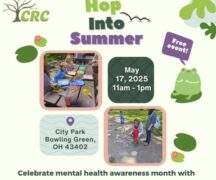By JULIE CARLE
BG Independent News
When it comes to mental health services in Wood County, residents have access to everything from prevention, promotion and intervention to treatment and recovery. A recent mental health conference, hosted by the National Alliance on Mental Illness Wood County, shared the mental health continuum of care accessible to Wood County residents from local agencies and organizations.
Prevention programs in Wood County schools are making a difference in behaviors such as alcohol, tobacco and other drug use, said Kyle Clark, director of Wood County Educational Service Center’s Prevention Education Program.
Based on the Wood County Youth Survey on Addiction and Mental Health that is conducted every two years with students in grades five through 12, alcohol, cigarette and marijuana use all dropped significantly in the 18 years since the survey started.
“Most recently, annual alcohol use and 30-day alcohol use were at 35.8% and 21.3%, respectively, down from 70.1% and 47.3% when the survey was first conducted. Similarly, current 30-day cigarette use fell to 1.7% from 27.2%, and annual marijuana use went from 30.3% in 2003 to 22.3% in 2023.
“The data is very good. It shows that over time, prevention has worked,” he said. “Student usage of alcohol, tobacco and other drugs in Wood County has decreased since 2003. The national data shows usage is also going down, but not at the rate ours is.”
Over the years, the survey has expanded to ask youth about mental health, bullying and relationship violence, gaming and gambling, and most recently, adverse childhood experiences.
Nine school districts and Penta Career Center work on prevention programs with the Educational Service Center. Each district has a prevention specialist for at least some amount of time each week, ranging from two days up to a full-time staff person five days a week.
“The full-time staff person is in the building as part of the school staff. Our people are there talking to teachers and seeing the relationships. That is what helps promote our programs,” said Angela Patchen, Prevention Education Program manager. “We served at least 4,000 individual, unduplicated students in the past year.”
Mental health promotion and education are the cornerstones of Courtney Rice’s work at NAMI Wood County. As manager of community education and marketing, Rice helps to market the different free programs, services and events that NAMI offers.
“A big part of promotion is education—educating the public about mental health, getting them started to have those conversations about mental health and to feel more comfortable talking about mental health and addiction,” she said.
NAMI programs often address the stigma surrounding mental health through advocacy and awareness. Billboards, events, and awareness messaging around different populations, are part of promotion’s efforts, she explained.
While NAMI doesn’t provide treatment, they advocate for individuals with mental illness, offer support groups to various constituents and help the public navigate the mental health system by referring them to the multitude of local service providers.
The Hope Institute, under the leadership of Derek Lee, is an outpatient facility that specializes in intervention and stabilization for individuals experiencing suicidal ideation, said Derek Lee, CEO of the Hope Institute and Perrysburg Counseling Services. They use two evidence-based practices that have been proven to treat suicidal ideation effectively.
Intervention is an action intended to interfere with and stop or modify a process to halt, manage or alter the course of any pathological processes of a disease or disorder. Treatment is the administration of appropriate measures, such as psychotherapy or drugs, that are designed to relieve a pathological condition. “Intervention changes a behavior and treatment takes care of or manages a condition,” Lee explained.
Crisis services in Wood County are available for children and adults. Children’s Resource Center provides mental health services, including crisis services, for children, said Danielle Kutan, director of emergency services at CRC. Unison Health has recently opened a crisis stabilization unit in Bowling Green for adults 18 years and up, said Jennifer Emahiser, Unison’s senior director of services in Wood County.
At CRC, family members, schools, law enforcement or clinicians can call to ask for a crisis assessment for youth who have suicidal ideation, aggressions, family conflict or are exhibiting self-harm. “We don’t turn anyone away,” Kutan said.
They have a 24/7 Mobile Response Stabilization Service that can assess the youth at any location in the county.
Unison utilizes a crisis line for adults in crisis—419-502 HOPE (4673)—to triage calls from clients or family members of individuals with mental illness. The service, staffed with licensed clinicians around the clock provide the initial assessment to determine if follow-up services are needed. Local law enforcement officials, clinicians and health care providers can call the unit directly.
Both CRC and Unison’s crisis stabilization unit said their response time is usually between 30-60 minutes.
After Denise Meine-Graham lost her teenage son to suicide in 2012, she founded LOSS Community Services, a nonprofit organization that supports individuals bereaved by suicide. She spoke about suicide postvention, which she called a form of prevention or intervention after a suicide.
As a consultant now, Meine-Graham advocates for LOSS teams in communities to be proactive and peer-based. “Their purpose is to install seeds of hope to those who are bereaved by suicide,” she said.
Crista Metzger-Leady and Amanda Like, both on the staff of NAMI Wood County, shared the agency’s recovery programs, especially highlighting the Wellness Recovery Action Plan (WRAP) workshop. WRAP helps individuals identify their own wellness tools, create a daily maintenance plan, as well as an action plan for identifying stressors and early warning signs. NAMI will offer a WRAP workshop June 22-23 from 10 a.m. to 4 p.m. at the NAMI office. Details are available on the NAMI website.





